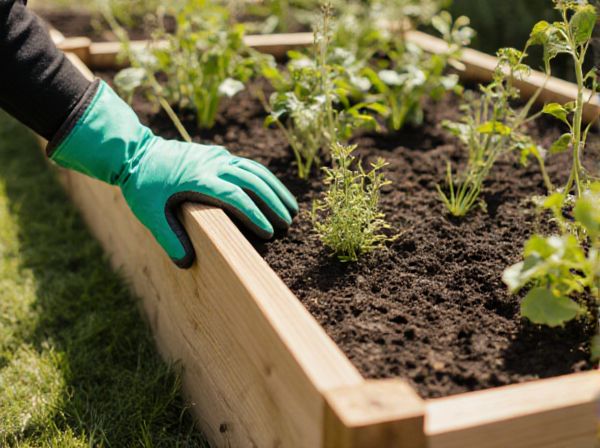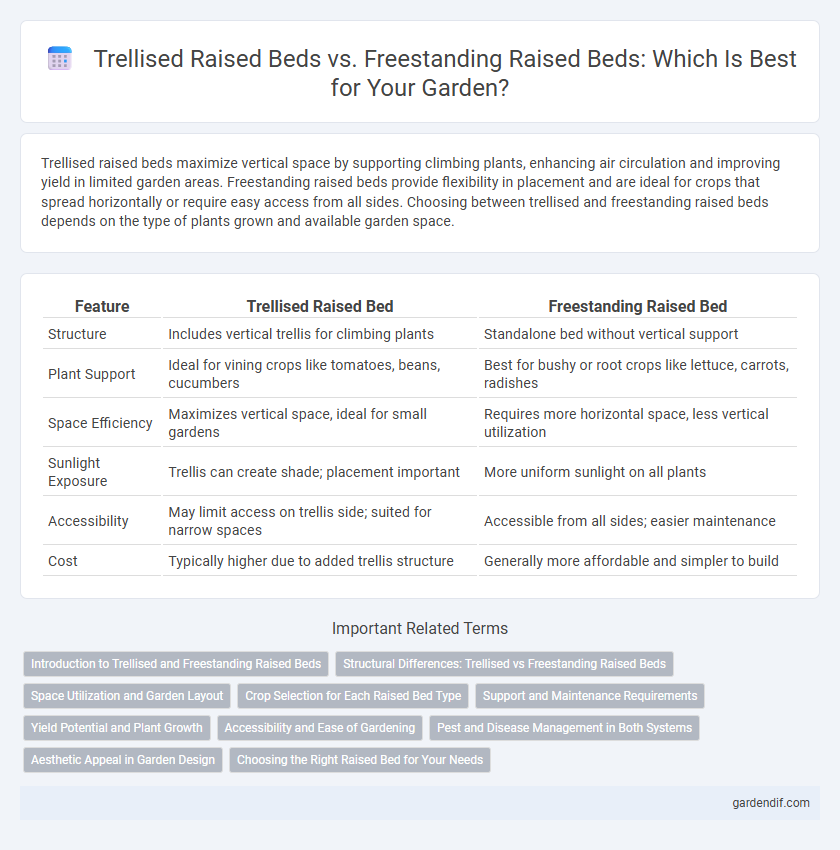
Trellised raised bed vs Freestanding raised bed Illustration
Trellised raised beds maximize vertical space by supporting climbing plants, enhancing air circulation and improving yield in limited garden areas. Freestanding raised beds provide flexibility in placement and are ideal for crops that spread horizontally or require easy access from all sides. Choosing between trellised and freestanding raised beds depends on the type of plants grown and available garden space.
Table of Comparison
| Feature | Trellised Raised Bed | Freestanding Raised Bed |
|---|---|---|
| Structure | Includes vertical trellis for climbing plants | Standalone bed without vertical support |
| Plant Support | Ideal for vining crops like tomatoes, beans, cucumbers | Best for bushy or root crops like lettuce, carrots, radishes |
| Space Efficiency | Maximizes vertical space, ideal for small gardens | Requires more horizontal space, less vertical utilization |
| Sunlight Exposure | Trellis can create shade; placement important | More uniform sunlight on all plants |
| Accessibility | May limit access on trellis side; suited for narrow spaces | Accessible from all sides; easier maintenance |
| Cost | Typically higher due to added trellis structure | Generally more affordable and simpler to build |
Introduction to Trellised and Freestanding Raised Beds
Trellised raised beds feature vertical supports that maximize growing space by allowing climbing plants such as beans, cucumbers, and tomatoes to grow upward, improving air circulation and sun exposure. Freestanding raised beds are self-contained garden units without vertical structures, ideal for growing ground-level crops like lettuce, carrots, and herbs in compact, accessible spaces. Both types enhance soil quality and drainage while reducing weed growth, but trellised beds optimize vertical gardening efficiency in limited areas.
Structural Differences: Trellised vs Freestanding Raised Beds
Trellised raised beds incorporate vertical support structures, such as wooden or metal frames, allowing climbing plants to grow upward, thus maximizing garden space and improving air circulation around the crops. Freestanding raised beds lack these vertical components, focusing solely on horizontal soil containment, which simplifies construction and is ideal for low-growing plants or root vegetables. The structural difference lies in the integration of trellis elements that enhance plant support and vertical gardening capabilities compared to the more basic, standalone design of freestanding beds.
Space Utilization and Garden Layout
Trellised raised beds maximize vertical space by supporting climbing plants like beans and cucumbers, enabling gardeners to grow more crops in a smaller footprint. Freestanding raised beds occupy only horizontal space, making them suitable for sprawling crops but potentially limiting the number of plants in compact gardens. Incorporating trellises optimizes garden layout efficiency, especially in limited spaces, by increasing planting density and improving airflow for healthier growth.
Crop Selection for Each Raised Bed Type
Trellised raised beds are ideal for climbing crops such as tomatoes, cucumbers, pole beans, and peas, maximizing vertical space and improving air circulation to reduce disease risk. Freestanding raised beds suit sprawling or low-growing crops like lettuce, carrots, radishes, and herbs, offering easy access and flexibility in planting arrangements. Choosing the appropriate raised bed type enhances crop yield by aligning plant growth habits with the bed's structural design.
Support and Maintenance Requirements
Trellised raised beds provide built-in vertical support for climbing plants, reducing the need for external structures and simplifying plant training and harvesting. Freestanding raised beds require additional supports like stakes or cages, increasing maintenance efforts to ensure stability and proper plant growth. The integrated trellis system in trellised raised beds optimizes space and minimizes ongoing upkeep compared to the higher maintenance demands of freestanding raised beds.
Yield Potential and Plant Growth
Trellised raised beds maximize vertical space, significantly increasing yield potential by supporting climbing plants such as tomatoes, beans, and cucumbers, which optimize sunlight exposure and airflow for enhanced plant growth. Freestanding raised beds offer flexibility in crop selection but generally result in lower yields compared to trellised beds due to limited vertical growth capability and denser plant spacing. Choosing trellised structures promotes healthier plants, improved pest management, and higher overall productivity in garden spaces.
Accessibility and Ease of Gardening
Trellised raised beds enhance accessibility by supporting vertical plant growth, reducing the need to bend or reach, which simplifies planting and harvesting. Freestanding raised beds offer open, unobstructed space that allows gardeners to move freely around all sides, making it easier to manage soil and tend to root crops. Both systems improve ease of gardening but cater to different needs: trellised beds optimize space vertically, while freestanding beds prioritize 360-degree access and flexibility.
Pest and Disease Management in Both Systems
Trellised raised beds offer enhanced pest and disease management by improving air circulation and reducing soil contact for climbing plants, which minimizes fungal infections and soil-borne pests. Freestanding raised beds may experience higher humidity and closer plant proximity to the soil surface, increasing the risk of pests like slugs and soil-dwelling pathogens. Strategic placement of trellises can also facilitate easier inspection and removal of infected foliage compared to freestanding beds, contributing to healthier crop growth.
Aesthetic Appeal in Garden Design
Trellised raised beds enhance garden design by adding vertical structure and visual interest, supporting climbing plants that create lush, dynamic focal points. Freestanding raised beds offer a clean, minimalist aesthetic, allowing versatile placement and unobstructed views of surrounding garden elements. Choosing between trellised and freestanding options depends on the desired balance between vertical greenery and open spatial design in the landscape.
Choosing the Right Raised Bed for Your Needs
Trellised raised beds maximize vertical growing space, making them ideal for climbing plants like beans, cucumbers, and peas, while freestanding raised beds provide versatile horizontal space suitable for a wider variety of crops and easier access for planting and maintenance. When choosing between trellised and freestanding raised beds, consider the types of plants you want to grow, available garden space, and the need for structural support to ensure optimal plant growth and yield. Soil quality, sunlight exposure, and ease of harvest also influence the decision, with trellised beds benefiting smaller footprints and freestanding beds offering more flexibility in layout.
Trellised raised bed vs Freestanding raised bed Infographic

 gardendif.com
gardendif.com